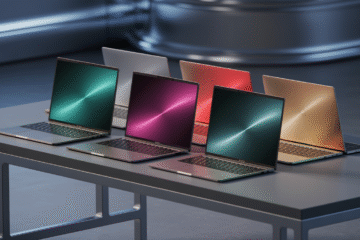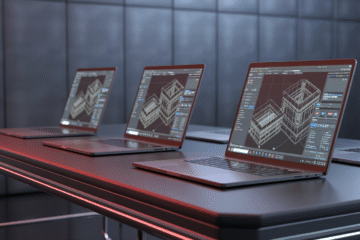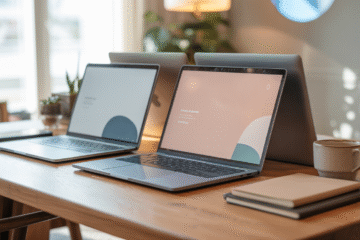Best Laptops with Long Battery Life (2025 Buyer’s Guide)
If your workday spans cafés, lectures, client sites, and flights, battery life becomes the most crucial specification on a laptop. Raw capacity isn’t the full story; efficiency, display tech, CPU architecture, background processes, and even your choice of ports all affect how long a machine lasts away from the charger. This guide explains what truly matters and ranks six excellent long-lasting options—spanning Windows and macOS, convertibles and clamshells—so you can pick the right companion for all-day work.
How to Judge “All-Day” Battery (What Actually Matters)
Battery capacity vs. real-world efficiency
A large battery (measured in watt-hours, Wh) helps, but modern chips and media engines can double practical life at the same capacity. Apple Silicon and the latest Intel/AMD platforms both lean heavily on hardware video decode/encode and efficiency cores to sip power during office work and streaming.
Display size, brightness, and refresh
The screen is your biggest battery draw. A 13–14″ panel at 250–300 nits with adaptive refresh typically lasts far longer than a bright 16–17″ at 400+ nits. OLED can be efficient with darker UIs; IPS often wins at static white backgrounds. 120Hz looks silky, but 60Hz conserves power.
Storage, RAM, and thermal design
Fast NVMe SSDs wake and sleep quickly. Adequate RAM prevents constant swapping that wastes energy. Good thermals reduce throttling and fan ramping—fans consume power and signal inefficiency.
Software discipline
Background sync, telemetry, and chat apps can quietly burn hours. Battery-saver modes, optimized power plans, and browser tab management matter more than most people realize.
The Rankings: Top 6 Long-Lasting Laptops
6-HP Spectre 7-155H Laptop — Premium 2-in-1 Endurance in a Stylish Shell
Who it’s for: Professionals and students who want a premium convertible with strong stamina, superb typing, and a color-credible display for creative reviews.
Why it stands out: The Spectre line is known for a well-tuned balance of performance and efficiency. The 7-155H keeps that tradition: adaptive performance modes, intelligent backlight control, and typically excellent battery optimization in HP’s software suite.
Real-world battery profile:
-
Mixed productivity (Wi-Fi on, 200–250 nits, doc + web + meetings): a full workday is realistic.
-
Streaming and note-taking: comfortable long sessions, especially with the display at or under 200 nits.
-
Creative bursts: photo edits and light 1080p video trimming are fine; heavy sustained loads shorten runtime.
Strengths: Premium build, comfortable keyboard, good microphones and webcam, rich I/O for a slim convertible.
Trade-offs: Bright touch OLED/IPS options look great but can cost an hour or more of endurance at high brightness; carry a compact USB-C charger if you frequently present in bright rooms.
5- KAIGERR AX17 Laptop — Big Screen, Bigger Battery Budget
Who it’s for: Users who need a 17″ display for timelines, spreadsheets, or side-by-side apps but still care about decent unplugged mileage.
Why it stands out: Large notebooks usually drain fast; the AX17’s appeal is pairing a big panel with a sensible power profile and roomy chassis that stays cool (cooler systems avoid throttling and excess fan draw). If you spend hours comparing code and logs or managing wide dashboards, the extra screen reduces time-wasting window shuffles.
Real-world battery profile:
-
Office work at moderate brightness: respectable for the size class.
-
Local video playback with hardware decode: better than expected given the 17″ panel.
-
Heavy compiles or 4K edits: plan on plugging in; large displays plus sustained CPU/GPU loads consume power quickly.
Strengths: Spacious canvas, comfortable thermals, often generous port selection (less dongle reliance saves power on external hubs).
Trade-offs: Heavier backpack footprint; if you push brightness past 300 nits all day, expect a noticeable drop in runtime.
4- Dell Vostro Business Laptop — Corporate-Class Stamina and Practicality
Who it’s for: Office and field professionals who want a predictable all-day battery, a repairable design, and ports that just work in conference rooms.
Why it stands out: Vostro models emphasize reliability and business ergonomics. Efficient CPU options, conservative power curves, and anti-glare displays help battery life in bright offices without maxing the backlight.
Real-world battery profile:
-
Email, docs, CRM, and calls: easily spans a meeting-heavy day at moderate brightness.
-
Travel days: power-efficient standby and quick-resume minimize drain between sprints of use.
-
Docked workflows: smart charging features preserve battery health for longevity.
Strengths: Stable thermals, anti-glare panels for real offices, Ethernet or reliable Wi-Fi 6/6E, and HDMI/USB-A save you from adapters.
Trade-offs: Displays are tuned for business—not HDR showpieces. If you need dazzling colors, plug into a calibrated external monitor at your desk.
3- HP Pavilion Touchscreen Laptop — Everyday Endurance with Convertible Convenience
Who it’s for: Students and home/office users who prefer touch for whiteboarding, annotating PDFs, and consuming content—without sacrificing a full day away from the outlet.
Why it stands out: Pavilion Touchscreen configurations tend to pair efficient processors with pragmatic displays and batteries. HP’s modern touch layers are responsive yet not overly power-hungry when you keep brightness sensible.
Real-world battery profile:
-
Lecture + research + note-taking: a typical school day is achievable, particularly in tablet/tent mode with lower brightness.
-
Video calls and split-screen study: still strong, though cameras and AI noise reduction will cost a bit of runtime.
-
Light creative use: basic photo adjustments and 1080p editing with proxies are fine on battery.
Strengths: Touch flexibility, approachable price, and solid battery for a convertible.
Trade-offs: Touch/OLED options and higher refresh panels shave hours at high brightness; consider IPS 60Hz if endurance is your priority.
2- Apple MacBook Pro Laptop — Marathon Battery Under Real Workloads
Who it’s for: Professionals who edit video, code for hours, or analyze data on the move and need a machine that stays fast and quiet off-charger.
Why it stands out: Apple Silicon combines high performance with class-leading efficiency. The MacBook Pro’s hardware media engines (H.264/H.265/HEVC/AV1, depending on chip) massively reduce CPU load during playback and export, translating to extraordinary unplugged longevity even while doing real creative work.
Real-world battery profile:
-
Mixed pro workloads (IDE + browser + Slack + light photo/video): truly all-day.
-
Video editing with optimized media: still impressive; fans are quiet, and the machine maintains speed on battery.
-
Long flights: watch hours of HDR content, review timelines, and handle communication tasks without power anxiety.
Strengths: Superb screen efficiency for the brightness, quiet thermals, fast wake, and consistent performance on battery.
Trade-offs: Purchase price is higher; some legacy ports still require a compact hub, depending on your devices.
1- Apple MacBook Air 13 Inch Laptop — The Efficiency Benchmark
Who it’s for: Anyone who prizes silence, weight, and endurance above all. The MacBook Air is the reference point for battery life in a thin-and-light.
Why it stands out: With no fans and aggressive efficiency at idle and light/medium loads, the Air often doubles the unplugged usable time of older ultraportables. Unified memory keeps multitasking snappy without constant disk thrash, and Apple’s power management is seamless.
Real-world battery profile:
-
Productivity day (Wi-Fi on, ~200 nits, docs/web/meetings): 10–15 hours is ordinary.
-
Code + research + light image edits: still comfortably into the evening.
-
Travel and campus days: standby drain is exceptionally low; open the lid and keep going.
Strengths: Best-in-class battery consistency, silent operation, quick sleep/wake, excellent speakers and display for the size.
Trade-offs: Fewer built-in ports than some Windows peers; serious 3D or heavy multicam edits are better suited to a MacBook Pro or a workstation laptop.
Use-Case Recommendations (Choose Smart, Not Just Big Batteries)
Long campus days, note-taking, and portability
-
Top pick: Apple MacBook Air 13 Inch Laptop
-
Windows alternative: HP Pavilion Touchscreen Laptop (choose an IPS 60Hz configuration for maximum battery).
Hybrid office, meetings, and reliable ports
-
Top pick: Dell Vostro Business Laptop
-
Alternative: HP Spectre 7-155H Laptop if you want a premium convertible feel and don’t mind carrying a small USB-C charger.
Large canvas without tethering all day
-
Top pick: KAIGERR AX17 Laptop
-
Tip: Keep brightness reasonable and leverage battery saver during reading/review tasks.
Creative pros on the move
-
Top pick: Apple MacBook Pro Laptop
-
Tip: Use optimized/proxy media in your NLE; Apple’s media engines will stretch battery hours further than you’d expect.
Configuration Tips That Directly Improve Battery Life
Pick the right display
-
Prefer 60–90Hz over 120Hz unless you truly need the smoothness.
-
Keep brightness between 150–250 nits in typical indoor spaces; use auto-brightness and true tone/night modes to reduce eye strain and power draw.
Choose memory and storage wisely
-
16GB RAM is the modern baseline; insufficient memory forces disk swapping, which eats power.
-
512GB–1TB NVMe ensures fast access and fewer long wake cycles.
Use the efficient path for video
-
When possible, use play formats that the hardware can decode efficiently. On macOS, first-party apps and many editors tap into media engines automatically. On Windows, modern browsers/players also leverage GPU decode—avoid odd transcoding workflows on battery.
Tune your OS power plan
-
Enable battery saver or low power mode.
-
Disable or delay heavy background sync.
-
Set the display and keyboard backlight to auto-off quickly when idle.
Mind your peripherals
-
High-resolution external displays and bus-powered drives drain quickly. When you must use them on battery, lower the external brightness and eject drives promptly after use.
Frequently Asked Questions
Is a bigger battery (Wh) always better?
It helps, but efficiency can outweigh raw capacity. A smaller, highly efficient system may outlast a larger, inefficient one at the same workload and brightness.
Do OLED screens always use more power?
Not always. Dark UIs and content can be very efficient on OLED. Bright, white backgrounds at high nits can consume more than IPS. Your apps and theme choice matter.
Can I get a true “two-day” battery?
With light workloads (email, notes, reading) and disciplined brightness, yes—especially on the MacBook Air and MacBook Pro. Heavy creative sessions or bright screens compress that timeline.
Does 120Hz kill battery?
Higher refresh rates use more power. Many laptops offer adaptive or switchable refresh; selecting 60Hz on battery can save hours.
Final Verdict
For the longest, quietest, most consistent unplugged experience, the Apple MacBook Air 13 Inch Laptop remains the category benchmark. If you need more sustained performance for creative suites but still want exceptional endurance, the Apple MacBook Pro Laptop is the clear step up.
On Windows, the Dell Vostro Business Laptop provides predictable all-day stamina with practical ports and reliable thermals, while the HP Pavilion Touchscreen Laptop gives students and everyday users a convertible form factor that still goes the distance. If a premium 2-in-1 is your style, the HP Spectre 7-155H Laptop brings endurance and polish. And if you can’t live without a large 17″ canvas, the KAIGERR AX17 Laptop offers credible battery life for its size—just manage brightness and background loads.
Whichever model you choose, remember that display settings, power plans, and background apps often matter as much as the battery itself. Tune those well, and you’ll turn a good laptop into an all-day machine.



0 Comments